Essequibo River
The Essequibo River (Spanish: Río Esequibo originally called by Alonso de Ojeda Río Dulce)[4][5] is the largest river in Guyana, and the largest river between the Orinoco and Amazon. Rising in the Acarai Mountains near the Brazil–Guyana border, the Essequibo flows to the north for 1,014 kilometres (630 mi) through forest and savanna into the Atlantic Ocean. With a total drainage basin of 156,828 square kilometres (60,552 sq mi) and an average discharge of 4,531–5,650 cubic metres per second (160,000–199,500 cu ft/s).
| Essequibo River Río Esequibo | |
|---|---|
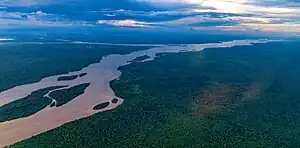 The Essequibo River in Guyana | |
 Map of the Essequibo drainage basin | |
| Location | |
| Country | Guyana |
| Physical characteristics | |
| Mouth | Atlantic Ocean |
• coordinates | 7°02′N 58°27′W |
• elevation | 0 ft (0 m) |
| Length | 1,014 km (630 mi) |
| Basin size | 156,828 km2 (60,552 sq mi) |
| Discharge | |
| • location | Atlantic Ocean, Guyana (near mouth) |
| • average | 5,650 m3/s (200,000 cu ft/s)[1] 178 km3/a (5,600 m3/s)[2] |
| Discharge | |
| • location | Plantain Island (Basin size: 66,563 km2 (25,700 sq mi) |
| • average | 2,832 m3/s (100,000 cu ft/s)[3] |
| Basin features | |
| Tributaries | |
| • left | Rupununi, Potaro, Mazaruni, Cuyuni |
Territory near the river is argued over by Venezuela and Guyana.[6] The river is administered by Guyana, though Venezuela considers that it is the natural border between both countries.
Geography
The river runs through the Guianan moist forests ecoregion.[7] The average annual rainfall in the catchment area is 2,174 mm.[8] There are many rapids and waterfalls (e.g., Kaieteur Falls on the Potaro River) along the route of the Essequibo, and its 20-kilometre (12 mi) wide estuary is dotted with numerous small islands. It enters the Atlantic 21 kilometres (13 mi) from Georgetown, the capital city of Guyana. The river features Murrays Fall, Pot Falls, Kumaka Falls,[9] and Waraputa Falls.[10]
Its many tributaries include the Rupununi, Potaro, Mazaruni, Siparuni, Kiyuwini, Konawaruk and Cuyuni rivers. For over 30 kilometres (19 mi) from its mouth, the river's channel is divided by the large flat and fertile islands of Leguan, about 28 square kilometres (11 sq mi), Wakenaam, about 44 square kilometres (17 sq mi), and Hogg Island, about 60 square kilometres (23 sq mi). Fort Island is off the eastern side of Hogg Island. Fort Zeelandia is located on the island, and was the seat of government of the country during the Dutch colonial era.[11] Sloth Island is an eco-tourism island in the river.[12]
Fauna
The river has a very rich fauna. More than 300 fish species are known from the Essequibo basin, including almost 60 endemics.[13] This may be an underestimate of the true diversity, as parts of the basin are poorly known. For example, surveys of the upper Mazaruni River found 36–39 species (variation in number due to taxonomy), of which 13–25% still were undescribed in 2013.[14] At least 24 fish species are restricted to Mazaruni River alone.[14]
During floods the headwaters of the Branco River (a part of the Amazon basin) and those of the Essequibo are connected, allowing a level of exchange in the aquatic fauna such as fish between the two systems.[15]
History
15th century
The first European discovery was by the ships of Juan de Esquivel, deputy of Don Diego Columbus, son of Christopher Columbus in 1498.[16] The Essequibo River is named after Esquivel. In 1499, Amerigo Vespucci and Alonso de Ojeda explored the mouths of the Orinoco and allegedly were the first Europeans to explore the Essequibo.[16] Alonso de Ojeda called it "Rio Dulce"[4][17] which means Sweet River in Spanish.
16th century
In 1596 Lawrence Kemys, serving as second-in-command of Walter Raleigh's British expedition to Guiana, led a force inland along the banks of the Essequibo River, reaching what he wrongly believed to be Lake Parime. The next year Kemys, in command of the Darling, continued the exploration of the Guiana coast and the Essequibo River.
17th century
The first European settlement in Guyana was built by the Dutch along the lower part of the Essequibo in 1615. The Dutch colony of Essequibo was founded in 1616 and located in the region of the Essequibo River that later became part of British Guiana.[16]
The Dutch colonists remained on friendly terms with the Native American peoples of the area, establishing riverside sugarcane and tobacco plantations.[16] In a document detailing instructions for the Dutch Postholder in Cuyuni, it was mentioned that Indians (Venezuelan Amerindians) trading in Chinese slaves to sell to people who lived along the Essequibo river were to be allowed to conduct their business.[18][19]
19th century
The Dutch deterred many attacks from the British, French and Spanish for nearly two centuries, though they would later cede their territory to the British in 1814.[16]
The Independence war of Venezuela beginning in the 19th century ended the missionary settlements. At this time, Britain needed to have a colony, besides Trinidad, to serve the large trade sailboats on their large travel trading route around South America. Venezuela claims that the Essequibo is the true border between it and Guyana, claiming all territory west of it. The boundary was set between Venezuela and Guyana's then colonial power, Great Britain in 1899 through an arbitration proceeding. A letter written by Venezuela's legal counsel, named partner Severo Mallet-Prevost of New York City law firm Curtis, Mallet-Prevost, Colt & Mosle alleged that the Russian and British judges on the tribunal had acted improperly and granted the lion's share of the disputed territory to Britain due to a political deal between Russia and the United Kingdom. As a result, Venezuela has revived its claim to the disputed territory.
In August 1995, there was an acid spill in the river by the Canadian mining company Cambior. An estimated 4 million cubic metres (140,000,000 cu ft) of waste laced with cyanide was released into the river causing much destruction.
Expeditions
1837-38
Sponsored by the Royal Geographical Society the German researcher Robert Hermann Schomburgk (1804-1865) investigated the river Essequibo and followed its course to the south-west, while Sipu River flows to a westerly direction. He specified the coordinates of the source at 0°41`northern latitude, while not giving a longitude.[20]
1908
In 1908 the German-American ichthyologist Carl H. Eigenmann traveled on river Essequibo and confluent Potaro. He described 336 fish species in these rivers.[21]
1969
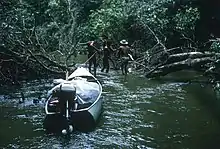
As part of a British Technical Assistance project "Operation El Dorado", geologists Dr. Jevan P. Berrangé and Dr. Richard L. Johnson made the first topographic and geological maps of Guyana south of latitude 4 degrees north. They examined 1:60,000 scale panchromatic aerial photos with a stereoscope to interpret the physical features and the geology of the region prior to making four expeditions into the field to check their observations. On Expedition III they explored the entire Essequibo basin. They travelled separately in two outboard-powered canoes, each team comprising a geologist and five Amerindians. Starting at Kanashen, they canoed up all the major eastward flowing tributaries: the Kuyuwini, Kassikaityu, Kamoa and Sipu rivers, as well as the Chadikar River which on the basis of its north-south trend and a larger flow of water is considered to be the source of the Essiquibo rather than the eastward flowing Sipu River. In his memoirs Richard Johnson records how he had a line cut through the forest to a small hill near the Chodikar headwaters so that he could stand on the border defined by the watershed, and when he told his line-cutting team that they were looking south across the forest into Brazil his foreman disagreed on the basis that "there are lots of nightclubs in Brazil." After mapping the tributaries the two teams joined forces and travelled down the Essequibo to its confluence with the Rupununi river at Apoteri.[22][23][24]
1971
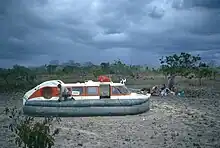
On February 26, 1971, an expedition set off by hovercraft from Manaus in Brazil where the Amazon River is joined by the Rio Negro. They followed the Negro upstream to where it is joined by the Rio Ireng that forms the border between Brazil and Guyana. After following the Ireng for a few tens of kilometers they hovered about 40 miles across the North Savannas of Guyana to the Rupununi River which they followed to it confluence with the Essequibo River at Apoteri. The Essequibo was then traversed down to its mouth near Georgetown. The primary purpose of the expedition was filming for the BBC series "The World About Us" with the episode "The Forbidden Route" broadcast in November 1971. The secondary purpose was to demonstrate the abilities of a new type of small hovercraft, the Cushioncraft CC7, thereby promoting sales of this British invention. The expedition team comprised Bob Saunders (BBC producer and team leader), Tommy Tomlinson (CC7 pilot), Jevan Berrangé (navigator and logistics consultant), Len Chrisophers (hovercraft engineer), Peter Smith (sound recordist), and Tony Morrison (cameraman). Fuel dumps for the hovercraft were laid down at intervals ahead of the expedition, by boat on the Rio Negro, by plane in the North Savannas and by float-plane on the Essequibo. As there were no reliable maps of the route, navigation in Guyana was done by 1:60,000 scale aerial photographs and by scouting rapids in a motorised inflatable dingy ahead of the CC7. This is the first expedition to travel by river, land, and sea from Manaus to Georgetown. A total distance of about 1,000 miles (1,600 km).[25]
2013

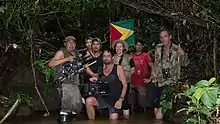
A Guyanese-German expedition in Guyana in April and May 2013 followed the course of the Sipu River to detect the still unknown headwaters of the Essequibo. It was sponsored by the French-German TV Company ARTE and was organized by Duane De Freitas (Rupununi Trails) and the film production team of Marion Pöllmann and Rainer Bergomaz (Blue Paw Artists). The responsible scientist for remote sensing, geodesy and mapping was Prof. Dr. Martin Oczipka from the University of Applied Sciences Dresden (HTW Dresden). The expedition was only realizable with the support of the Guyanese government and the indigenous tribe of Wai-Wai-Amerindian settling in the very south of Guyana.
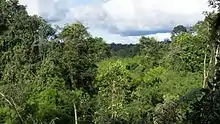

With the support of the Wai-Wai, satellite maps, topographic maps, GPS and a small drone, the source valley was discovered in 2013. The coordinate determined by expedition teams in 2013 deviates by approximately 40`, which corresponds to a distance of at least 80 km north. This could be caused by calculation errors or other mistakes. Possibly he followed a different branch of the river more in the South of Guyana. To further investigate this, additional research is necessary, preferably in the original reports of Robert Hermann Schomburgk from his expedition in 1837/38. For the accurate determination of the headwaters and their proper classification, further extensive geological and hydrological studies are necessary.
2018
In 2018, with the support of the First Lady, Sandra Granger, a group consisting of five Wai-wai, two English, one Iranian, and one South African located the furthest source of the Essequibo River. They built upon information and experience from the above 2013 Guyanese German expedition alongside topographical maps, local Wai Wai knowledge, GPS, and machetes to follow the Sipu River to its source. The multinational team 'Running the Essequibo' followed the main channel and investigated tributaries until they reached the watershed. There, 20 metres away from the Brazilian border, they logged what is now acknowledged to be the furthest source of the Essequibo River.
GPS co-ordinates: N1'24.5243, W59'16.5107
The team then began their world-first descent of the Essequibo River. The team of nine paddled back to Kanashan, aka Gunns Strip, where the Wai Wai members returned home and Romel Shoni and Anthony Shushu joined the expedition. This team, accompanied later further downriver by Fay James (Macushi people), then paddled the remaining distance to the mouth of the Essequibo where it meets the Atlantic Ocean.
This expedition lasted a total of 10 weeks.
Team members: Laura Bingham (expedition leader), Ness Knight, Pip Stewart, Peiman Zekavat (film director), Jon Williams (cameraman), Nereus Chekema, Nigel Isaacs, Jackson (Elijah) Marawanaru, Aron Marawanaru, James Suse, Fay James, Romel Shoni, and Anthony Shushu.[26]
See also
References
- "Verkenning effecten Versnelde zeespiegelstijging op dynamiek Westerschelde estuariene systeem" (PDF). 18 Jun 1998.
- Likens, Gene E. (20 May 2010). Biogeochemistry of Inland Waters. Academic Press. ISBN 978-0-12-381997-0.
- Faustino, Morales (1999). GEOGRAFÍA FÍSICA DEL TERRITORIO EN RECLAMACIÓN GUYANA ESEQUIBA. Fondo Editorial Humanidades. ISBN 980-00-1617-1.
- Navarrete, Martín Fernández de (1829). Colección de los viages y descubrimientos que hicieron por mar los españoles desde fines del siglo XV: con varios documentos inéditos concernientes á la historia de la marina castellana y de los establecimientos españoles en Indias (in Spanish). Imprenta real.
- Rojas, Juan Fernández de (1828). El Páxaro en La liga: epistola gratulatoria al traductor de La liga de la teologia moderna con la filosofia (in French). en la oficina de Don Benito Cano.
- Ince, Basil. "The Venezuela-Guyana Boundary Dispute in the United Nations". Caribbean Studies.
- Schipper, Jan; Teunissen, Pieter; Lim, Burton, Northern South America: Guyana, Suriname, French Guiana, northern Brazil, and eastern Venezuela (NT0125), retrieved 2017-04-03
- UNEP (Jan 2016). Transboundary Waters: A Global Compendium (TWAP) - Water System Information Sheets: Southern America - Volume 6 - Annex C: Southern America (PDF). ISBN 978-92-807-3531-4.
- "Natural". Archived from the original on 2012-02-18. Retrieved 2012-01-20.
- "Ornamental Garden Plants of the Guianas" (PDF). naturalhistory.si.edu. Retrieved 2021-01-01.
- Lloyd Kandasammy. "A brief history of Dutch forts in Guyana History This Week". Land of Six People. Retrieved 26 November 2021.
- "Sloth Island Nature Resort – one of Guyana's best kept secrets". Kaieteur News Online. Retrieved 12 December 2021.
- Hales, J., and P. Petry: Essequibo. Freshwater Ecoregions of the World. Retrieved 24 May 2014.
- Karen M. Alofs; Elford A. Liverpool; Donald C. Taphorn; Calvin R. Bernard; Hernán López-Fernández (2013). "Mind the (information) gap: the importance of exploration and discovery for assessing conservation priorities for freshwater fish". Diversity and Distributions. 20 (1): 1–7. doi:10.1111/ddi.12127.
- Quinn, J.A.; S.L. Woodward, eds. (2015). Earth's Landscape: An Encyclopedia of the World's Geographic Features. Vol. 1. p. 142. ISBN 978-1-61069-445-2.
- The Statesman's Yearbook 2017: The Politics, Cultures and Economies of the World (153 ed.). Springer Publishing. 28 February 2017. p. 566. ISBN 978-1-349-68398-7.
- Colección de los viages y descubrimientos que hicieron por mar los españoles desde fines del siglo XV, 3: con varios documentos inéditos ... (in Spanish). Imprenta Real. 1829.
- Venezuela–British Guiana Boundary Arbitration: The case of the United States of Venezuela Before the Tribunal of Arbitration. Vol. 2. New York: The Evening Post Job Printing House. 1898. p. 127. Retrieved 2010-07-14.
- United States. Commission to investigate and report upon the true division line between Venezuela and British Guiana (1896). Report and accompanying papers of the Commission appointed by the President of the United States "to investigate and report upon the true divisional line between the republic of Venezuela and British Guiana". Govt. print. off. p. 248. Retrieved 2010-07-14.
chinese slaves dutch.
- Schomburgk, Robert Hermann (1841). Robert Hermann Schomburgk's Reisen in Guiana und am Orinoko. Während der Jahre 1835-1839. Nach seinen Berichten und Mittheilungen an die geographische Gesellschaft in London. Leipzig: Otto Alfred Schomburgk. p. 317.
- Eigenmann, C. H.; Calvert, Philip P.; Carriker, M.A. Jr. (1910). Annals of the Carnegie Museum Volume VI. 1909-1910. Board of Trustees of the Carnegie Institute: Holland, W.J.
- Berrangé, J. P. & Johnson, R. L. 1972. A guide to the Essequibo River, Guyana. Geographical Journal, Vol. 138, Part 1, pp 41-52, map 1:700,00.
- Berrangé, J. P. 1977. The geology of Southern Guyana, South America. Institute of Geological Sciences, Overseas Memoir No 4, 111 p. Tectonic-Geological and Geomorphological Maps. 1;500,000
- Berrangé, J. P. 2015, Operation El Dorado - A geological mapping project in Southern Guyana 1966–1971. Self published, 67 p., 2 maps.
- The World About Us: The Forbidden Route; BBC film archives; First broadcast November 21st, 1971
- Expedition website. Sidetracked article. The times article. LandRover article. The express article.
- Vegamián, Félix María de (Father, Order of Friars Minor Capuchin). El Esequivo, frontera de Venezuela. Documentos históricos y experiencias personales. Madrid: Talleres Tipográficos Raycar S. A., 1968.
- Eigenmann, C. H.: "Reports on the expedition to British Guiana of the Indiana University and the Carnegie Museum, 1908. Report no. 1. Some new genera and species of fishes from British Guiana". Annals of the Carnegie Museum, 6(1), 1909.